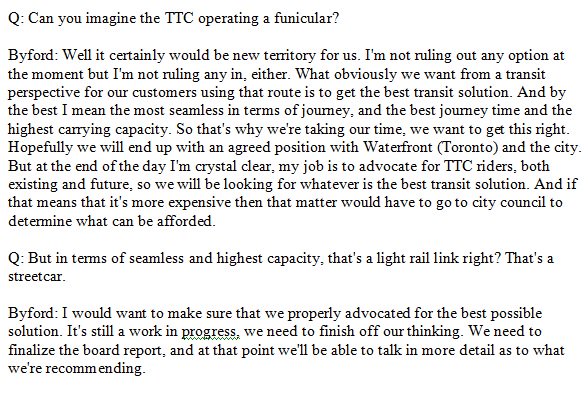You are using an out of date browser. It may not display this or other websites correctly.
You should upgrade or use an alternative browser.
You should upgrade or use an alternative browser.
mdrejhon
Senior Member
AlvinofDiaspar
Moderator
On a lighter note - perhaps they are looking at the wrong supplier...this might work a lot better:

(from Wiki by NipponBill https://en.wikipedia.org/wiki/Conveyor_belt_sushi#/media/File:Sushi_conyeyor_chain_1.jpg)
AoD

(from Wiki by NipponBill https://en.wikipedia.org/wiki/Conveyor_belt_sushi#/media/File:Sushi_conyeyor_chain_1.jpg)
AoD
am29
Active Member
The should study a connection from Union to the Islands using York St. 
Leo_Chan
Senior Member
Yes of course, The Toronto Islands deserve a subway!The should study a connection from Union to the Islands using York St.
44 North
Senior Member
Replace the sushi with chopped liver and that could be an official render
crs1026
Superstar
Tonight's public meeting in Etobicoke was informative, in the read-between-the-lines kind of way.
One attendee asked point blank "Who is the one in favour of this non-streetcar solution to the streetcar loop?"
The response, not exact words but close enough was, "The streetcar loop is an expensive proposition. We were asked to offer something cheaper. We aren't the ones making the decision, we are just doing our job by providing possible alternatives as we were asked to".
Which says to me that this is about Toronto Council, and sticker shock.
- Paul
One attendee asked point blank "Who is the one in favour of this non-streetcar solution to the streetcar loop?"
The response, not exact words but close enough was, "The streetcar loop is an expensive proposition. We were asked to offer something cheaper. We aren't the ones making the decision, we are just doing our job by providing possible alternatives as we were asked to".
Which says to me that this is about Toronto Council, and sticker shock.
- Paul
Leo_Chan
Senior Member
They should have proposed an even more expensive solution, extending the subway U to Queens Quay. Then Council will see expanding the loop is magnitudes less than the best solution, therefore they will choose that instead of the extremely high solution and the low low cost solutions.Tonight's public meeting in Etobicoke was informative, in the read-between-the-lines kind of way.
One attendee asked point blank "Who is the one in favour of this non-streetcar solution to the streetcar loop?"
The response, not exact words but close enough was, "The streetcar loop is an expensive proposition. We were asked to offer something cheaper. We aren't the ones making the decision, we are just doing our job by providing possible alternatives as we were asked to".
Which says to me that this is about Toronto Council, and sticker shock.
- Paul
CapitalSeven
Senior Member
The proposal does look like standard-issue funiculars like the one in Istanbul, which is quite effective, except that there is no significant change in elevation. It's really just the same technology on a flat surface. It sounds as though there would be roughly one car pulling in and out for each subway train pulling in and out, so there should be no reason to build up crowds. If it ran consistently, it would probably do the job quite well. Not that I'm advocating for it. The transfer at QQ is still a big issue, and as others have pointed out, why a 3.5 billion subway in Scarborough to avoid a transfer walk of about 80 feet, then this in the heart of the business and tourism district?
44 North
Senior Member
Tonight's public meeting in Etobicoke was informative, in the read-between-the-lines kind of way.
One attendee asked point blank "Who is the one in favour of this non-streetcar solution to the streetcar loop?"
The response, not exact words but close enough was, "The streetcar loop is an expensive proposition. We were asked to offer something cheaper. We aren't the ones making the decision, we are just doing our job by providing possible alternatives as we were asked to".
Which says to me that this is about Toronto Council, and sticker shock.
- Paul
Didn't make it to any meeting so thanks for the candid account of what is likely the key question of the Reset. I wouldn't discount higher level involvement in the cost reduction options. As in: we ain't funding this unless it's cheap. Would make sense. And with the Loop Extension option dropped, all options for Union are arguably on the cheaper side.
Wonder why we seldom see cost reduction options shortlisted for projects in more politically-important areas. Certainly see a lot of upgraded options, not many downgraded options, and probably never bat**** crazy downgrades like a walkaltor or people mover. Still can't get over how they made it this far.
AlvinofDiaspar
Moderator
The proposal does look like standard-issue funiculars like the one in Istanbul, which is quite effective, except that there is no significant change in elevation. It's really just the same technology on a flat surface. It sounds as though there would be roughly one car pulling in and out for each subway train pulling in and out, so there should be no reason to build up crowds. If it ran consistently, it would probably do the job quite well. Not that I'm advocating for it. The transfer at QQ is still a big issue, and as others have pointed out, why a 3.5 billion subway in Scarborough to avoid a transfer walk of about 80 feet, then this in the heart of the business and tourism district?
To be fair, the length of walk argument for the subway is always the weakest so I tend not to take it seriously compared to the overall convenience factor. Having said that, I can't imagine redoing this loop will cost more than the STC station/bus terminus combo - and this is Union Station we're talking about, the ne plus ultra of transit in the region.
AoD
Monarch Butterfly
Superstar
From this link, there is a report on the
Waterfront Transit Reset
The Executive Committee will consider on January 24, 2018 this report, see link.

What would be of interest to this thread is this comment, from this pdf, at this link.
Do NOT go with the automated funicular technology option. Better to expand the loop at Union Station.
Waterfront Transit Reset
The Executive Committee will consider on January 24, 2018 this report, see link.

What would be of interest to this thread is this comment, from this pdf, at this link.
3. City Council direct the Deputy City Manager, Cluster B, and the Acting Chief Planner and Executive Director, City Planning, in partnership with the Toronto Transit Commission and Waterfront Toronto, to complete a focused feasibility study of light rail and automated funicular technology options for connecting transit below grade between Union Station and Queens Quay, and the extension of light rail along Queens Quay East, and report back on the preferred overall solution, including a refined cost estimate and next steps for design and construction, to the Executive Committee in the second quarter of 2019 or earlier.
Do NOT go with the automated funicular technology option. Better to expand the loop at Union Station.
DSCToronto
Superstar
More of a turkey, I think!My question: Who the heck first chose the word "funicular" when it is a duck?
Monarch Butterfly
Superstar
The Report from the Deputy City Manager, Cluster B on Waterfront Transit Network Plan at this link goes into more detail.


c) Union Station – Queens Quay Link - Direction Summary
The link between Union Station and Queens Quay East is a critical component in the overall waterfront transit network. This 540 metre section has the highest projected transit ridership in the network, connecting the largest transit hub in the Greater Toronto Area to the overall waterfront. The existing streetcar loop is inadequate to serve current ridership needs (to and from the west), and the loop would not function effectively or safely considering future growth and if additional service from the east was added.
The forecast transit ridership confirms the need for LRT technology to serve Lower Bay, Lower Yonge, the East Bayfront, and beyond to the Port Lands. In terms of the underground link to Union Station, a short list of potential transportation technology solutions was assessed and refined, each which can accommodate future forecasted transit demand to and from Union Station.
A major expansion of the Union Station streetcar loop was previously approved through the East Bayfront Transit Class EA (2010). Option A1 is a revision to the EA-approved concept with cost and construction risk mitigation considerations (platform relocation and removal of future Bremner Blvd transit link). Option A2 further reduces the scale of the EA approved concept by reducing the number of platforms. Both options include shifting LRT platforms away from under the Union Station Rail Corridor to the 45 Bay development site, which includes some pre-build elements to accommodate transit.
Options B and C were added to the list as potential cost saving solutions, and in recognition of the growth along the lower Bay corridor as well as significant existing and forecast number of trips travelling a relatively short distance to/from Union Station.
All of the options were presented to the public and stakeholders, and the general feedback indicated that “B” Options presented significant disadvantages for future users over “A” and “C” Options. Generally, one-way operation of a moving sidewalk, overall accessibility inconveniences, and removal of an existing transit link were identified as negative factors by the general public and stakeholders. The negative factors outweighed the potential positives of weather protected pedestrian access to existing and future development at multiple points along lower Bay Street. Consequently, "B” Options have been removed from further assessment as a replacement option to the existing transit link.
The design of the funicular option has not been developed to the same level of detail as the loop expansion option, and consequently, the potential benefits or drawbacks require further assessment. There are many factors to consider, but in terms of the travel time factor, the funicular may offer a benefit for shorter distance trips between Union Station and the Bay/Queens Quay area, and a drawback for longer distance trips between Union Station and the broader waterfront. TTC staff have expressed concern with any proposal that would eliminate direct streetcar service to Union Station, such as the option of a funicular in a repurposed tunnel.
Further focused analysis and assessment of both light rail expansion and automated dual-haul funicular technology options is recommended in order to reach a solution for this portion of the transit network. The focused analysis and assessment would include east-west light rail transit along Queens Quay as part of the solution.
The forecast (southbound direction, AM peak hour) transit-only trips for the Union-Queens Quay link is high, at approximately 3,700, and both Options A or C may accommodate this forecast demand. Further to this, the forecast (southbound direction, AM peak hour) combined pedestrian and transit movements in the corridor is very high, at potentially more than 10,000. This multi-mode factor will be also considered in the further analysis as there are opportunities for mutual benefits.
Attachments
Last edited:
Allandale25
Senior Member
^ And here are the visuals for the options they looked at for the loop from this report (same link as above but separate PDF):









